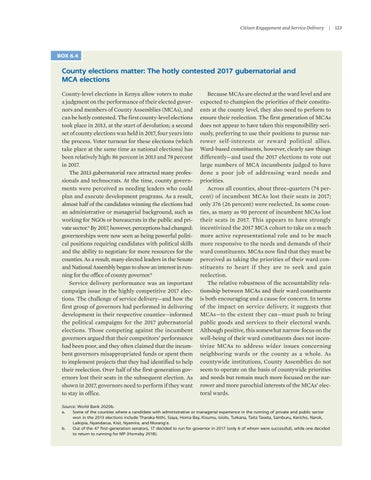Citizen Engagement and Service Delivery
|
BOX 6.4
County elections matter: The hotly contested 2017 gubernatorial and MCA elections County-level elections in Kenya allow voters to make a judgment on the performance of their elected governors and members of County Assemblies (MCAs), and can be hotly contested. The first county-level elections took place in 2013, at the start of devolution; a second set of county elections was held in 2017, four years into the process. Voter turnout for these elections (which take place at the same time as national elections) has been relatively high: 86 percent in 2013 and 78 percent in 2017. The 2013 gubernatorial race attracted many professionals and technocrats. At the time, county governments were perceived as needing leaders who could plan and execute development programs. As a result, almost half of the candidates winning the elections had an administrative or managerial background, such as working for NGOs or bureaucrats in the public and private sector.a By 2017, however, perceptions had changed: governorships were now seen as being powerful political positions requiring candidates with political skills and the ability to negotiate for more resources for the counties. As a result, many elected leaders in the Senate and National Assembly began to show an interest in running for the office of county governor.b Service delivery performance was an important campaign issue in the highly competitive 2017 elections. The challenge of service delivery—and how the first group of governors had performed in delivering development in their respective counties—informed the political campaigns for the 2017 gubernatorial elections. Those competing against the incumbent governors argued that their competitors’ performance had been poor, and they often claimed that the incumbent governors misappropriated funds or spent them to implement projects that they had identified to help their reelection. Over half of the first-generation governors lost their seats in the subsequent election. As shown in 2017, governors need to perform if they want to stay in office.
Because MCAs are elected at the ward level and are expected to champion the priorities of their constituents at the county level, they also need to perform to ensure their reelection. The first generation of MCAs does not appear to have taken this responsibility seriously, preferring to use their positions to pursue narrower self-interests or reward political allies. Ward-based constituents, however, clearly saw things differently—and used the 2017 elections to vote out large numbers of MCA incumbents judged to have done a poor job of addressing ward needs and priorities. Across all counties, about three-quarters (74 percent) of incumbent MCAs lost their seats in 2017; only 376 (26 percent) were reelected. In some counties, as many as 90 percent of incumbent MCAs lost their seats in 2017. This appears to have strongly incentivized the 2017 MCA cohort to take on a much more active representational role and to be much more responsive to the needs and demands of their ward constituents. MCAs now find that they must be perceived as taking the priorities of their ward constituents to heart if they are to seek and gain reelection. The relative robustness of the accountability relationship between MCAs and their ward constituents is both encouraging and a cause for concern. In terms of the impact on service delivery, it suggests that MCAs—to the extent they can—must push to bring public goods and services to their electoral wards. Although positive, this somewhat narrow focus on the well-being of their ward constituents does not incentivize MCAs to address wider issues concerning neighboring wards or the county as a whole. As countywide institutions, County Assemblies do not seem to operate on the basis of countywide priorities and needs but remain much more focused on the narrower and more parochial interests of the MCAs’ electoral wards.
Source: World Bank 2020b. a. Some of the counties where a candidate with administrative or managerial experience in the running of private and public sector won in the 2013 elections include Tharaka Nithi, Siaya, Homa Bay, Kisumu, Isiolo, Turkana, Taita Taveta, Samburu, Kericho, Narok, Laikipia, Nyandarua, Kisii, Nyamira, and Murang’a. b. Out of the 47 first-generation senators, 17 decided to run for governor in 2017 (only 6 of whom were successful), while one decided to return to running for MP (Hornsby 2018).
123


